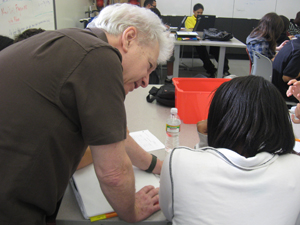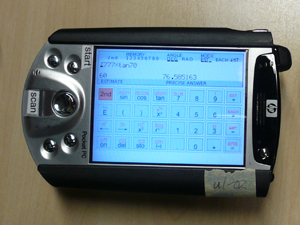Calit2 Inventor Creates Estimating Calculator to Help Hone Students' Math Skills
San Diego, CA, Dec. 8, 2008 — Call it the calculator for "thinking people."
|
QAMA, or Quick Approximate Mental Arithmetic, is a new kind of calculator designed and developed by Ilan Samson, an "inventor-in-residence" at the California Institute for Telecommunications and Information Technology (Calit2) at the University of California, San Diego. Rather than providing an instantaneous result at the stroke of the "equal" sign, QAMA requires the user to provide a reasonable estimation of the answer. If the approximation is approved for the given task by the calculator's sophisticated adaptive algorithm, QAMA provides the exact answer as confirmation.
"Our hope is that this calculator becomes the only one allowed in the classroom," Samson remarked. "It will mean that every time a student touches a calculator, they have to do some thinking in their head. Right now, with the current calculators students are using, that isn't happening at all."
The idea for QAMA (pronounced "kaama") stemmed from a book Samson wrote in 2005. Titled "Demathtifying: Demystifying Mathematics" the book argues that many of the methods currently used in mathematics courses virtually guarantee that students will never understand math.
"I've always been interested in the phenomenon of why math education is a failure," he explained. "Kids spend more time learning math than any other subject, but aside from a few gifted ones, they come out without any ability to do math beyond basic arithmetic. What's more, science education falls apart not because kids don't like to know how things work — it falls apart the moment things start to get mathematical.
"But math is no more difficult than many of the games that kids play, and they play those accurately," he mused. "I finally began to put my finger on the problem: Math was mainly being instructed rather than explained. When the teacher instructs something, the students just follow the recipe to achieve the same result. They just memorize their multiplication tables, which is useless because they don't know how they arrive at a particular answer. What they need to know is how to deduce the material on their own, based on common sense and understanding. With this calculator, they could access this information only after working it out and keying it in."
The motivation behind QAMA reflects current educational research, which suggests that calculators are useful tools in the classroom, but only if students already have basic math skills. A study published in the August issue of the Journal of Experimental Child Psychology compared the performance of two groups of third graders: One group was asked to solve multiplication problems using a calculator, and the other was asked to generate answers on their own. The students were then tested on their multiplication skills without the use of a calculator. The researchers found that for those students who already had some multiplication skills, using the calculator before the test had no impact. But for those who were poor at multiplication beforehand, prior use of a calculator actually had a negative impact.
|
QAMA has already begun to generate excitement at San Diego's High Tech High (HTH), where two ninth-grade math classes recently tested out a prototype of the calculator. In a letter to Samson, HTH's Chief Academic Officer Ben Daley reported that after using QAMA for only one week, students demonstrated 80 percent gains on a pre/post test of estimation skills.
"More importantly, students appeared to be engaged by the device and even thought of it as a game to beat," Daley wrote. "Students could be seen looking intently at the QAMA to see if they 'got it right.'"
"What happened there was remarkable," Samson said of his experience working with the students. "The teachers told me they have a rule that children should be kept at a task for as many minutes as their age. These students were between 13 and 14 years old, but here they were, sitting day after day for well over an hour, working away like adults, on their own. They didn't have to be coaxed in any way.
"Going into this, the question was whether or not the kids would like it," he continued. "After all, they get it all 'for free' on a calculator, so why would they need this? I kept pointing out to the critics that the satisfaction of getting an 'estimate accepted' would override the nuisance of having to work out the answer, and I was right. After all, they make a much bigger effort to score useless points in video games.
"And with video games," he added, "kids get scolded for wasting time. With QAMA, they get praised for working."
Researchers have long understood that students enjoy using calculators simply because they're electronic devices, but Samson pointed out that they can also be used as a tool for improving students' self-esteem in math classes.
|
"It's a little like playing chess," he explained. "You cannot learn to play chess unless you actually play it, but the big limitation is that you can practice only by letting yourself being humiliated. But if you use an electronic chess game, no one knows if you're playing badly. It's the same with QAMA: Only the calculator knows if your estimate was declined. This induces the students to try much harder because they can do it on their own."
Samson came to Calit2 to develop the calculator at the invitation of Paul Yu, a professor of Electrical and Computer Engineering (ECE) at UCSD, who had read Samson's book and saw the value in his approach to teaching math. While at the institute, Samson worked with ECE undergraduate Ricky Huang to install the ready software into a hand-held prototype for QAMA (which, when pronounced phonetically, also means "how much" in Samson's native Hebrew).
With Huang volunteering his time (often well into the early morning hours), the team required only six weeks to complete the prototype. It was finished on a Friday, four months to the day after Samson arrived in the U.S. from his home in England. By the following Monday, the units were being tested out in the classroom.
"If I would have stayed in England, this would have never happened so quickly," notes Samson, who said he has so many patents in his name he's "lost count."
"When a new idea comes up in most places outside the U.S., it's regarded as a potential nuisance, whereas here its regarded as a priority, an opportunity. My colleagues here were not only prepared to do develop QAMA, they were keen to do so. I'm certain that if I had come to the U.S. earlier, this calculator would already been on the market.
"The collaboration I received at Calit2 — there are no words to describe it. And it's gotten such a good reception at UCSD. Frieder Seible (the dean of UCSD's Jacobs School of Engineering) has said he would like to see this calculator be the only one that could be used at UCSD, beginning today!"
Altogether, Samson and Huang created 22 copies of QAMA, which are written in C programming language and were fashioned from iPAC hand-held devices leftover from Calit2's Wireless Internet Information System for Medical Response in Disasters (WIISARD) project. Samson says the greatest challenge was creating a compact estimation algorithm that would prepare a reasonable tolerance for any calculation.
|
QAMA is also incredibly cost-effective: Each device costs approximately $5 when mass-produced, and the estimation feature can be turned off at will, allowing QAMA to be used like a traditional calculator (this functionality can be prevented in the classroom, however).
So what's the next step in the evolution of QAMA? "
"World domination," says Huang.
"To put it simply, we're hoping that this will do more for math education than anything else out there," Samson concluded. "We've proven that the students like it; the next step is to get this in the hands of every kid in the world."
Related Links
High Tech High
Demathtifying: Demystifying Mathematics
Media Contacts
Tiffany Fox, (858) 246-0353, tfox@ucsd.edu




